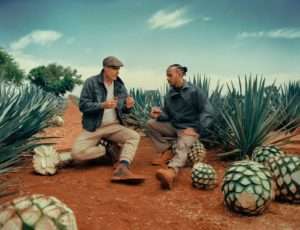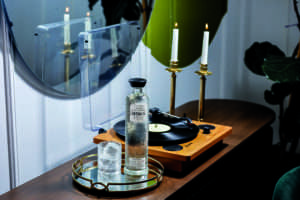A potion that cured everything, from indigestion to scorpion stings, was given by the indigenous people from the Mexican Ópata tribe to German Jesuit missionaries who arrived in Mexico some 300 years ago. It was a fermentation of agave, a cuviso (remedy in the Ópata language) that the missionaries admired as a holy remedy, a “santo cuviso”.
Santo Cuviso Bacanora Blanco is an agave spirit made from the agave agustifolia, a cousin of the espadín agave. Javier Oroz, a partner at Casa Santeros, the producer of Santo Cuviso, technically describes bacanora as a mezcal, because its production process is the same, but legally different, because it is a designation of origin: “The distillation of the agave is something culture in Mexico. Records of people making mezcal or agave distillates can be found in Yucatán, Nuevo León, Oaxaca, Baja California, etc. Laws arose that limit the production of beverages to certain places, so we have Tequila, Mezcal, Raicilla, Sotol, Bacanora, Comiteco, or Pulque. These denominations are a legal consequence, but the entire Mexican territory is unique due to its link with the agave”.
In addition to its origin, Javier mentions other differences between mezcal and bacanora, related to the climate and soil conditions in Sonora that cause the plants, the agave agustifolia, to take on a different shape, size, and sugar content. The agave agustifolia in Sonora has thinner leaves than the agave in Oaxaca, for example, and the piñas (heart of the agave) are smaller and with more sugar, making cooking and fermentation faster.
But how special are those conditions in Sonora? It is here, when talking about this territory, that Javier reveals his emotion and admiration for Sonora, the land of Santo Cuviso. Sonora is the second largest state in Mexico, located in the northwest of the country, below Arizona. The climate is extreme, during the summer it is one of the hottest places in the world, and during the winter it has temperatures below 0. People struggle with the weather, the long distances from one place to another, and the lack of water, the rain is like a blessing that rarely occurs. Javier explains that “Sonora has a desert weather and soil that we don’t find in other places in Mexico and all these conditions make animals, plants and people need to be strong and resilient, but also to appreciate resources more… Bacanora reflects these unique characteristics that you will only find in Sonora”.
Bacanora has a long history that began before it was called by its denomination of origin. In Sonora, many tribes used the fermentation of the agave for different purposes such as medicine or religious ceremonies. Then the Jesuits arrived and began to distill agave due to the lack of wine and grapes. After the Mexican revolution, a right-wing ideological leader was the governor of Sonora, Plutargo Elías Calles, and in 1925 he banned the production and consumption of mezcal because he believed it made people violent and immoral. He created a special police force called Acordada, and if someone was found guilty, they received the death penalty. However, mezcal production continued in the mountains, far from the authorities, and thus survived. Later, Plutargo became president of Mexico and contradictorily offered parties to politicians and the military where he brought mezcal from Sonora, from a distillery located in the town of Bacanora. Instead of saying that they brought mezcal, people said that they brought bacanora, so this name became popular.
Bacanora obtained the designation of origin in the year 2000 and became the only agave distillate that is produced in a single state in Mexico. Today its production is the second most important activity in Sonora, where there are around 70 distilleries.
The passion for agave spirits and the tradition that emerged after several years of prohibition in Sonora united the partners of Casa Santeros. These entrepreneurs created Casa Santeros to reconnect with a four-generation family ranch, Rancho San Isidro, located in southern Sonora.
Its holy bacanora blanco, Santo Cuviso, was recognized by the American Distilling Institute with the “Best of Class – Certified Craft Distilled Spirit Award” in the Agave International 2019 category. It is dry, and complex, with a hint of pepper and an earthy finish. Its characteristics allow it to be paired with any meal. However, we believe that Javier’s description of the ideal tasting of this drink exceeds all expectations: “The perfect scenario would be the San Isidro ranch, a 7,000-hectare ranch, with a breathtaking landscape. The perfect idea is to do a sensory tasting where you can pair typical food with bacanora and boost the sensation with a landscape that matches what you are drinking. If you go to a place that is difficult to access, with cactus, with the typical nature that you find in Sonora, to taste Santo Cuviso, for example, with dried meat, or with “cecina”, which is also a very typical dish, you can put all your senses to work and have an amazing sensory experience”.





